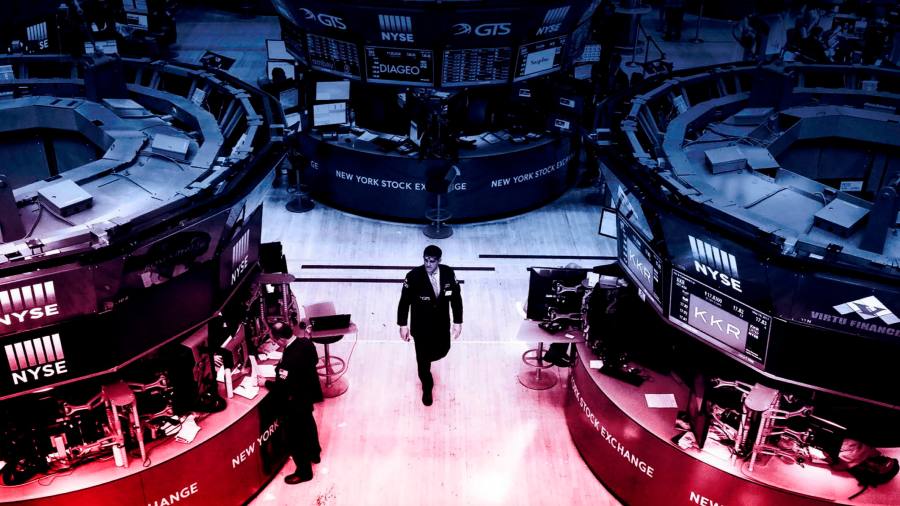Good morning. It’s Jenn Hughes here in New York, helping out Ethan while Rob is away. Silicon Valley Bank is attracting short sellers, the FT reports, following a soured bet on mortgage-backed securities hurt by rising rates. Bank troubles with securitisations sound too 2008 for words. But then, right now almost everything is hostage to the Federal Reserve in some form. Is there any other game in town? Email me: [email protected].
Markets extend Presidents’ Day sales
Monday’s Presidents’ Day holiday in the US is about honouring the leaders of the free world — and also the first big retail discounts of the year. On Tuesday Wall Street came back from bargain-hunting white goods and put virtually the entire stock market on sale.
The S&P 500 is still almost 4 per cent higher so far this year, but that’s less than half its February 2 peak when it boasted a near-9 per cent gain. Tuesday’s 2 per cent fall was its worst in two months. On Wednesday the selling eased, but the general gloom persisted and blue-chips once again closed lower.
Tuesday is worth revisiting because there wasn’t an obvious cause of the misery. Early blame went to a so-so outlook from Walmart and Home Depot’s warning of weaker full-year earnings on flat sales. But Walmart was one of the few stocks to end Tuesday higher and it was hardly a surprise that everyone’s favourite lockdown home renovation store was struggling as the housing market slows.
That lack of a specific cause brings this all back to the Federal Reserve and the cranking higher of interest rate expectations since the stupendously strong February 3 jobs numbers, followed by higher inflation data and buoyant retail sales.
The key, says Eric Theoret, global macro strategist at Manulife Investment Management, is the scale of the change in thinking. Break-even rates paint a simpler, more stark picture than interest rate futures:
Break-evens — the difference between yields on regular and inflation-protected bonds with similar maturity — are a market prediction of inflation rates. Since January, two-year break-evens have shot up from 2 per cent or thereabouts, to 3 per cent, well above the Fed’s inflation target.
“You had a Fed that could look at break-evens then and say ‘mission accomplished’ in terms of inflation expectations but since payrolls on February 3, you’ve had these massive shifts in the economy that say there’s actually a lot more work to be done,” Theoret added.
It’s an ongoing adjustment, in other words. The minutes of the Fed’s February 1 meeting, released on Wednesday, support that too. Remember Jay Powell’s talk then of disinflation, and the unanimous vote for a quarter-point rate rise? The record shows more than one member actually supported a half-point increase.
Said the Fed:
A few participants stated that they favoured raising the target range for the federal funds rate 50 basis points at this meeting or that they could have supported raising the target by that amount.
Given this inflationary gloom, stock markets need a fresh catalyst to shake off their misery. The current earnings season has been heavier on caution than the sort of optimism that might encourage new bets.
Moreover, even the heavy selling of recent weeks hasn’t yet reduced the market to the sort of extreme bearish mood that makes it easier to find a new buying spur. Here, Bespoke Investment Group charts sentiment by the S&P 500’s distance from its 50-day moving average. On this measure, stocks may have fallen sharply, but they’re only in neutral territory:
Remember that January rally? With neither sentiment nor macro on the market’s side, it feels a world away.
Fiddling while Canberra fumes
If you thought Powell had a tough job, spare a thought for Philip Lowe. The governor of the Reserve Bank of Australia is fighting similar economic forces but is also under fire ahead of a government-ordered review of the RBA’s performance, due next month.
It’s one to watch since central banking policymaking often follows broad global trends. Think of the move to greater central bank independence in the mid-1990s, or more recently the shift to greater transparency embodied by Powell’s 2018 introduction of press conferences after every rate-setting meeting.
The RBA faces mounting public anger, not least because of its 2021 prediction that it didn’t expect it would need to raise rates until 2024 at the earliest. Lowe & Co were hardly alone in underestimating inflation, but all (economic) news is local. Domestic reports abound of household pain, exacerbated by the country’s use of floating-rate mortgages, which the RBA reckons make up more than 60 per cent of home loans.
For Australians, the RBA has been tightening at an unprecedented pace, although the Fed’s actions mean Americans might wonder what the Aussies are so unhappy about:
Lowe hasn’t helped himself. Earlier this month he was blasted for declining to give an annual public address but still attending a private lunch for bank traders days after the RBA delivered an unexpectedly hawkish outlook. “Yields rose as Lowe, traders lunched” trumpeted the Australian Financial Review’s scoop story.
The danger is that the more the unassuming Lowe is made to look Nero-like, the more likely that the review’s findings are reduced to a political weapon. There are more than a few governments around the world that might like a chance to shift some economic criticism and budget debates on to wonkish rate-setters. US debt ceiling, anyone?
One good read
Why QT isn’t proving the watching-paint-dry experience that Janet Yellen promised.
Read the full article here



